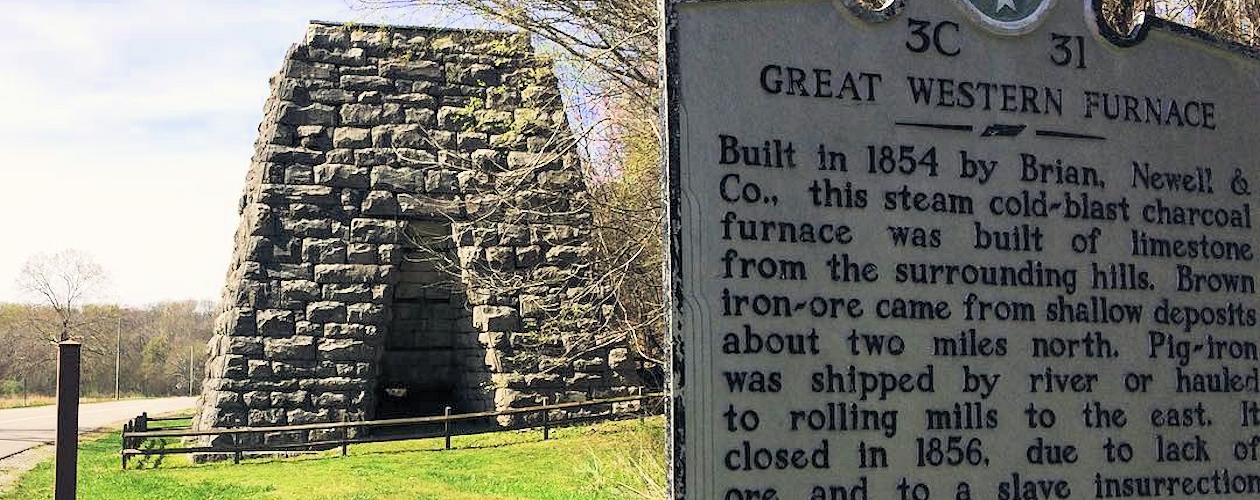The Industrial Revolution Makes Its Way to the South
If you've spent much time on this website, then you've already figured out that the lands which comprise the Land Between the Lakes National Recreation Area are flooded with historic artifacts and oddities that make it an intriguing destination for history lovers.
It's fascinating to examine the cultural identities of the small communities that once thrived in a region called "Between the Rivers." It's also intriguing to learn about the industries that once fueled the economies of these small towns. One 19th Century industry that had a short life span in the region, and yet left an indelible mark on the people who lived here, was iron ore production.
The Industrial Revolution of the early to mid-1800s created a need for the production of iron. With the availability of iron ore found in natural resources such as hematite, as well as abundant deposits of limestone and timber, the lands Between the Rivers seemed ripe for this industry to thrive. It is said that the introduction of the iron ore industry to western Kentucky and middle Tennessee was the first place where the Industrial Revolution began to make its mark on the southern states.
Iron Ore Production
Using the natural resources available in the Between the Rivers woodlands, large furnaces were constructed by wealthy investors in the 1840s and 50s. In some cases, these furnaces were manned by as many as 200 workers, including African-American slaves prior to the Civil War. These workers lived in communities built up around the furnace and produced a type of ore called "pig iron." The ore was easily shipped to factories using the region's rivers, which served as valuable and affordable shipping tools for the iron ore industry to transport their goods.
The area that we now know as the Land Between the Lakes was once home to eight iron furnaces. After the Tennessee Valley Authority (TVA) established Lake Barkley, some of these old iron furnaces were immersed under the lake waters and as far as we know their remnants could still be found there today. Two such furnaces include Mammoth Furnace and Fulton Furnace. Other furnaces simply deteriorated and in one case only a historic marker is left to designate the former spot where the Laura Furnace once stood.
Iron Furnaces Still Visible Today
Only two of the eight furnaces are visible to tourists today. Those include The Great Western Iron Furnace, which is believed to have been built around 1854, and Center Furnace, established around 1852.
The Great Western Iron Furnace
The Great Western Iron Furnace is located on the site where Model, TN, once stood. It is one of the best preserved of the iron furnaces in this region, mostly due to its brief years of operation from 1854-56. Its short life has been blamed on its poor location, which made it difficult to transport natural resources in and finished products out. It is also thought that by the time of the furnace's operations, the commercial demand for pig iron had significantly decreased.
The site of the furnace is located along The Trace, just south of The Homeplace 1850s Working Farm and Living History Museum.
Center Furnace
Center Furnace has disintegrated quite a bit more than the site of the Great Western Iron Furnace. It was in operation intermittently from about 1852-1912. While little of the furnace is to be seen on this historic spot, there is a trail that points you to the various historic artifacts that played a role in the iron ore production that took place here at the Center Furnace.
Cisterns and various tools can be seen, as well as a replica of a charcoal hearth that would have been used in the iron ore smelting process. Also found on this site is the grave of Dr. Thomas T. Watson, an early investor and business partner of Daniel Hillman, the founder of Center Furnace.
Center Furnace can be accessed via the Silver Trail Road near Hematite Lake and the Woodlands Nature Station.
The End of an Era
By the time of the Civil War the iron ore industry in the Between the Rivers region was nearing a halt and by 1880 many of the natural resources had been depleted. The last furnace ended production around 1927. It was located in Stewart County, TN.
Nearly Two Centuries Later
While most of the physical buildings are no longer viewable, the rich history of the iron ore industry in Western Kentucky and middle Tennessee is still alive today. Visitors to these former industrial sites can still find shallow ponds that once served as iron ore surface mines, cliffs of limestone that remain from abandoned mines, forested lands stripped of vegetation where charcoal heaps once stood and a few abandoned railroad beds.
Other historic remnants include the blue hematite rocks you'll find along the pathways and trails surrounding these iron furnaces. These rocks were formed as a by-product of the iron ore smelting process that took place on these lands. They are considered an historic artifact, much of them now at least 150 years old, and they are not to be removed.
For those seeking other things to do in the area, there are several hiking trails and attractions located near these old iron furnaces, including Hematite Lake and Trail, Long Creek Trail, Honker Lake Trail and the Woodlands Nature Station.
Before You Go
So, if you're looking for an affordable way to entertain the family and learn a little more about the history of the lands found Between the Rivers, a stop by the two remaining iron furnaces located within the Land Between the Lakes National Recreation Area is a must.
More Attractions & Lodging in Land Between The Lakes
The Great Western Iron furnace is just one of several sights to see in Land Between The Lakes. If you aren't staying at one of LBL's campgrounds, consider a resort, hotel or motel, or other Lodging options just outside Land Between The Lakes.








